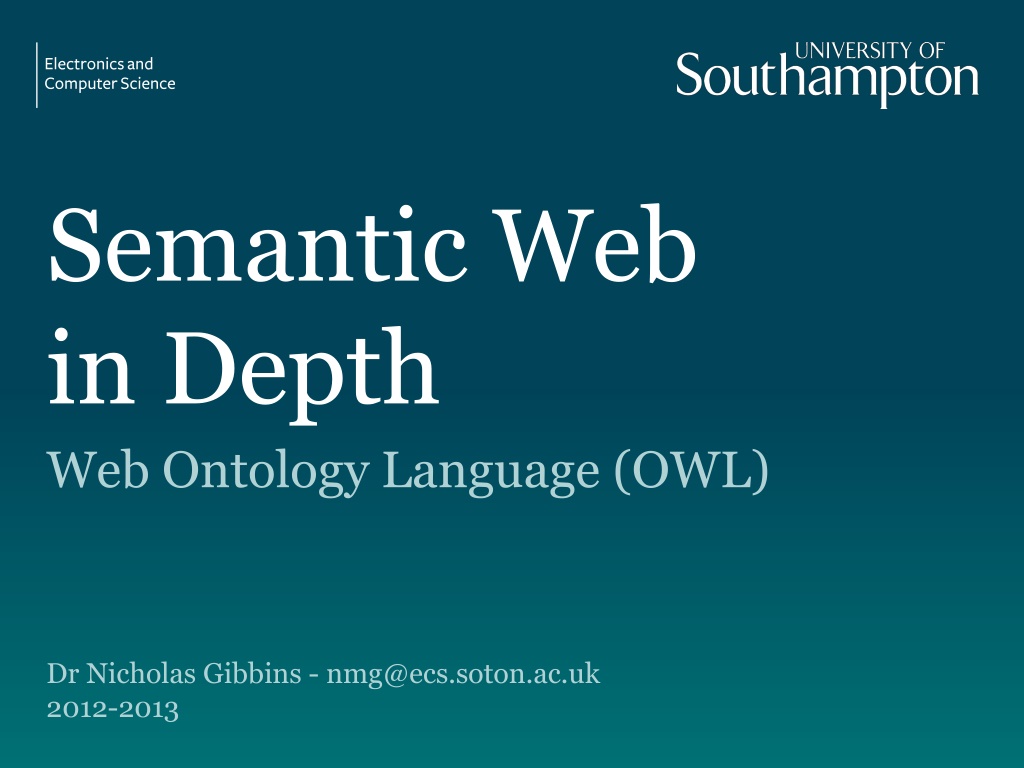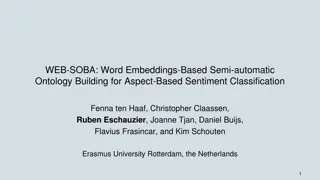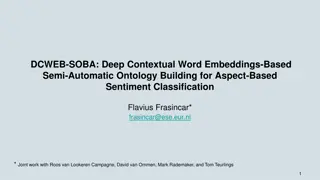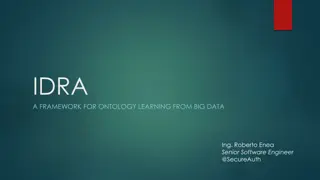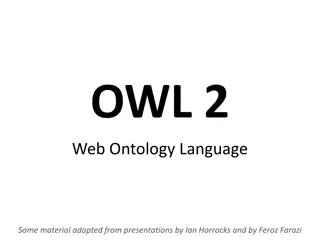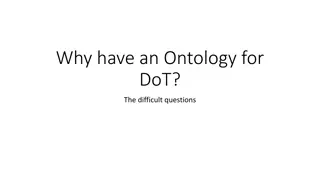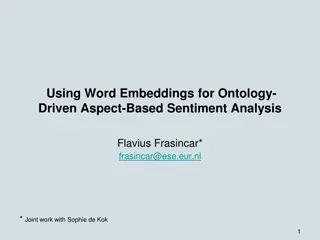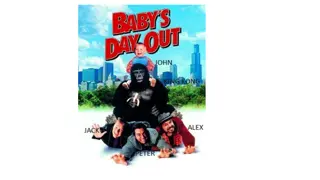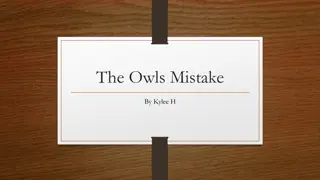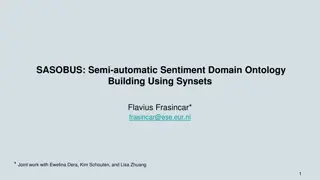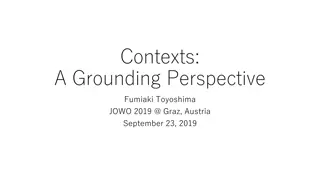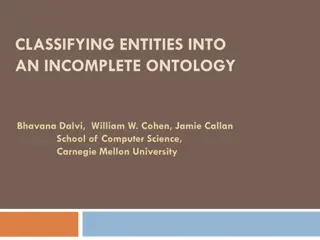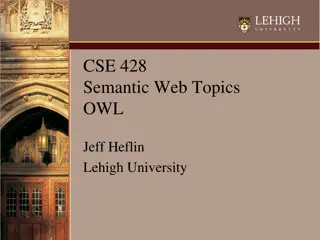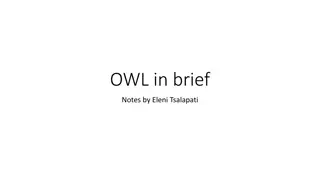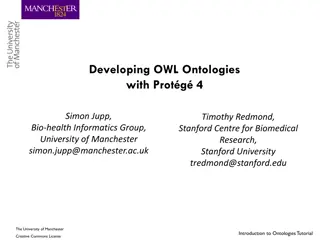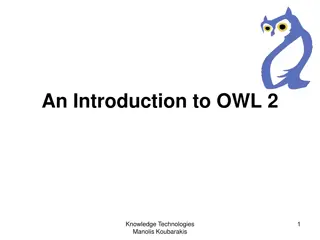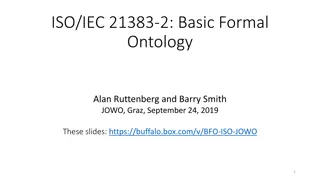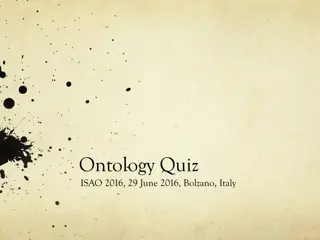Understanding OWL (Web Ontology Language) in Depth
Delve deep into the intricacies of OWL, a powerful ontology language designed for instance classification, consistency checking, and subsumption reasoning. Explore its features, versions, species, and trade-offs between expressiveness and reasoning complexity.
Download Presentation

Please find below an Image/Link to download the presentation.
The content on the website is provided AS IS for your information and personal use only. It may not be sold, licensed, or shared on other websites without obtaining consent from the author. Download presentation by click this link. If you encounter any issues during the download, it is possible that the publisher has removed the file from their server.
E N D
Presentation Transcript
Semantic Web in Depth Web Ontology Language (OWL) Dr Nicholas Gibbins - nmg@ecs.soton.ac.uk 2012-2013
Introducing OWL For many, RDF Schema is a sufficiently expressive ontology language However, there are use cases which require a more expressive formalism: -Instance classification -Consistency checking -Subsumption reasoning
OWL Feature Summary Necessary and sufficient conditions for class membership Property restrictions Local range, cardinality, value constraints Equivalence and identity relations Property characteristics Transitive, symmetric, functional Complex classes Set operators, enumerated classes, disjoint classes
OWL Versions Two versions of OWL: OWL 1.0 (became Recommendation on 10 Feb 2004) OWL 2 (became Recommendation on 29 Oct 2009) OWL 2 is more expressive than OWL 1.0, and takes advantage of developments in DL reasoning techniques in the intervening time We will initially concentrate on OWL 1.0
OWL 1.0 Species Different subsets of OWL features give rise to the following sublanguages (colloquially known as species): OWL Lite OWL DL OWL Full There is a tradeoff between the expressiveness of a representation language and the difficulty of reasoning over the representations built using that language. Brachman, R. J., and H. J. Levesque. (1984). The tractability of subsumption in frame-based description languages. In Proceedings of the 4th National Conference of the American Association for Artificial Intelligence (AAAI-84). Austin, TX, pp. 34-37.
OWL 1.0 Species OWL Full Increasing complexity Increasing expressivity OWL DL OWL Lite RDF(S)
OWL Lite Description Logic-based SHIF(D) Less complex reasoning at the expense of less expressive language No enumerated classes, set operators, or disjoint classes Restricted cardinality restrictions (values of 0 or 1 required, permitted and excluded) No value restrictions equivalentClass/subClassOf cannot be applied to class expressions
OWL DL Description Logic-based SHOIN(D) Complete and decidable Higher worst-case complexity than OWL Lite Supports all OWL constructs, with some restrictions Properties that take datatype values cannot be marked as inverse functional Classes, properties, individuals and datatype values are disjoint
OWL Full No restrictions on use of language constructs All OWL DL and RDFS constructs Potentially undecidable
OWL 1.0 Features and Syntax
Ontology header Ontology header for metadata <owl:Ontology rdf:about= > <owl:versionInfo>1.4</owl:versionInfo> <rdfs:comment>An example ontology</rdfs:comment> <owl:imports rdf:resource="http://www.example.org/base"/> </owl:Ontology>
Versioning support Version properties used in the ontology header owl:versionInfo Version number, etc owl:priorVersion Indicates that an ontology is a previous version of this owl:backwardCompatibleWith Indicates that the specified ontology is a previous version of this one, and that this is compatible with it owl:incompatibleWith Indicates that the specified ontology is a previous version of this one, but that this is incompatible with it
Versioning support Classes and properties may be marked as deprecated owl:DeprecatedClass owl:DeprecatedProperty
OWL class types owl:Class Distinct from rdfs:Class needed for OWL Lite/DL owl:Thing ( ) The class that includes everything owl:Nothing ( ) The empty class
OWL property types owl:ObjectProperty The class of resource-valued properties owl:DatatypeProperty The class of literal-valued properties owl:AnnotationProperty Used to type properties which annotate classes and properties (needed for OWL Lite/DL)
OWL versus RDF Schema Recall that the semantics of a description logic is specified by interpretation functions which map: Instances to members of the domain of discourse Classes to subsets of the domain of discourse Properties to sets of pairs drawn from the domain of discourse Reflexive definitions of RDF Schema means that some resources are treated as both classes and instances, or instances and properties
OWL versus RDF Schema Ambiguous semantics for these resources Can t tell from context whether they re instances or classes Can t select the appropriate interpretation function The introduction of owl:Class, owl:ObjectProperty and owl:DatatypeProperty eliminates this ambiguity
OWLs Dirty Secret OWL Full OWL DL OWL Lite RDF(S)
OWLs Dirty Secret Uncovered OWL Full OWL DL OWL Lite RDF(S) RDF(S)
OWL restrictions Class expression formed by constraints on properties Local cardinality constraints n R, n R, = n R Local range constraints R.C, R.C Local value constraints R.{x} Key concept in OWL
OWL restriction format <owl:Restriction> <owl:onProperty rdf:resource= property /> constraint expression </owl:Restriction>
Local cardinality constraints Defines a class based on the number of values taken by a property owl:minCardinality ( n R) property R has at least n values owl:maxCardinality ( n R) property R has at most n values owl:cardinality (= n R) property R has exactly n values OWL Lite has restricted cardinalities
Local cardinality constraint example Single malt whiskies are whiskies which are distilled by one and only one thing <owl:Class rdf:about= #SingleMaltWhisky > <owl:equivalentClass> <owl:Class> <owl:intersectionOf rdf:parseType="Collection"> <owl:Class rdf:about= #Whisky /> <owl:Restriction> <owl:onProperty rdf:resource= #distilledBy /> <owl:cardinality>1</owl:cardinality> </owl:Restriction> </owl:intersectionOf> <owl:Class> </owl:equivalentClass> </owl:Class>
Local range constraints Defines a class based on the type of property values Distinct from global range constraint (rdfs:range) in RDF Schema owl:someValuesFrom ( R.C) there exists a value for property R of type C owl:allValuesFrom ( R.C) property R has only values of type C Can only be used with named classes or datatypes in OWL Lite
Local range constraint example Carnivores are things which eat some things which are animals ( eats.Animal) <owl:Class rdf:about= #Carnivore > <owl:equivalentClass> <owl:Restriction> <owl:onProperty rdf:resource= #eats /> <owl:someValuesFrom rdf:resource= #Animal /> </owl:Restriction> </owl:equivalentClass> </owl:Class>
Local range constraint example Vegetarians are things which eat only things which are plants ( eats.Plant) <owl:Class rdf:about= #Vegetarian > <owl:equivalentClass> <owl:Restriction> <owl:onProperty rdf:resource= #eats /> <owl:allValuesFrom rdf:resource= #Plant /> </owl:Restriction> </owl:equivalentClass> </owl:Class>
Local value constraints Defines a class based on the existence of a particular property value owl:hasValue ( R.{x}) property R has a value which is X Cannot be used in OWL Lite
Local value constraint example Green things are things which are coloured green ( R. { Green }) <owl:Class rdf:about= #GreenThing > <owl:equivalentClass> <owl:Restriction> <owl:onProperty rdf:resource= #hasColour /> <owl:hasValue rdf:resource= #Green /> </owl:Restriction> </owl:equivalentClass> </owl:Class>
Set constructors owl:intersectionOf (C D) owl:unionOf (C D) owl:complementOf ( C) Restrictions on use with OWL Lite owl:unionOf and owl:complementOf cannot be used owl:intersectionOf can be used with named classes (not bNodes) and OWL restrictions only
Set constructors example <owl:Class rdf:about= GreenApple > <owl:equivalentClass> <owl:Class> <owl:intersectionOf rdf:parseType= Collection > <owl:Class rdf:about= Apple > <owl:Restriction> <owl:onProperty rdf:resource= hasColor /> <owl:hasValue rdf:resource= Green /> </owl:Restriction> </owl:intersectionOf> </owl:Class> </owl:equivalentClass> </owl:Class>
Equivalence and identity relations Useful for ontology mapping owl:sameAs owl:equivalentClass (C D) owl:equivalentProperty (R S) <owl:Thing rdf:about= #MorningStar > <owl:sameAs rdf:resource= #EveningStar /> </owl:Thing>
Non-equivalence relations owl:differentFrom Can be used to specify a limited unique name assumption <rdf:Description rdf:about= #HarryCorbett > <owl:differentFrom rdf:resource= #HarryHCorbett /> </rdf:Description> OWL (and DLs in general) make the Open World Assumption Knowledge of world is incomplete If something cannot be proven true, then it isn t assumed to be false
Non-equivalence relations owl:AllDifferent and owl:distinctMembers Used to specify a group of mutually distinct individuals <owl:AllDifferent> <owl:distinctMembers rdf:parseType= Collection > <rdf:Description rdf:about= #John /> <rdf:Description rdf:about= #Paul /> <rdf:Description rdf:about= #George /> <rdf:Description rdf:about= #Ringo /> </owl:distinctMembers> </owl:AllDifferent>
Necessary Class Definitions Primitive / partial classes ( ) If we know that something is a X, then it must fulfill the conditions... Defined using rdfs:subClassOf
Necessary and Sufficient Class Definitions Defined / complete classes ( ) If something fulfills the conditions..., then it is an X." Defined using owl:equivalentClass
Property types - Inverse Defines a property as the inverse of another property (R S-) <owl:ObjectProperty rdf:about= #hasAuthor > <owl:inverseOf rdf:resource= #wrote /> </owl:ObjectProperty>
Property types - Symmetric Symmetric properties satisfy the axiom P(x,y) iff P(y,x) <owl:SymmetricProperty rdf:about= #hasSibling />
Property types Transitive Transitive properties satisfy the axiom P(x,y) and P(y,z) implies P(x,z) <owl:TransitiveProperty rdf:about= #hasAncestor />
Property types Functional Functional properties satisfy the axiom P(x,y) and P(x,z) implies y=z <owl:FunctionalProperty rdf:about= #hasNINumber /> (everyone has only one NI number)
Property types Inverse Functional Inverse functional properties satisfy the axiom P(y,x) and P(z,x) implies y=z <owl:InverseFunctionalProperty rdf:about= #hasNINumber /> (people with the same NI number are the same person) Cannot be used with owl:DatatypeProperty in OWL Lite/DL
Disjoint classes owl:disjointWith members of one class cannot also be members of some specified other class <owl:Class rdf:about= #MaleHuman > <rdfs:subClassOf rdf:resource= #Human /> <owl:disjointWith rdf:resource= #FemaleHuman /> </owl:Class> Cannot be used in OWL Lite
Enumerated classes Defines a class as a direct enumeration of its members owl:one of (C {a,b,c}) Cannot be extended (closed set) Cannot be used in OWL Lite
Enumerated classes example <owl:Class rdf:about= #Continents > <owl:oneOf rdf:parseType= Collection > <owl:Thing rdf:about= #Africa /> <owl:Thing rdf:about= #Antarctica /> <owl:Thing rdf:about= #Oceania /> <owl:Thing rdf:about= #Europe /> <owl:Thing rdf:about= #North-America /> <owl:Thing rdf:about= #South-America /> <owl:Thing rdf:about= #Asia /> </owl:oneOf> </owl:Class>
Ontology modularisation owl:imports mechanism for including other ontologies Also possible to use terms from other ontologies without explicitly importing them Importing requires certain entailments, whereas simple use does not require (but also does not prevent) those entailments
Ontology modularisation example Ontology 1 (ont1) contains: BBB rdfs:subClassOf AAA Ontology-2 (ont2) contains: ont2 imports ont1 CCC rdfs:subClassOf BBB Ontology-2 must entail CCC rdfs:subClassOf AAA
Ontology modularisation example Ontology 1 (ont1) contains: BBB rdfs:subClassOf AAA Ontology-3 (ont3) contains: CCC rdfs:subClassOf ont1:BBB Ontology-3 does not necessarily entail CCC rdfs:subClassOf ont1:AAA
OWL status WebOnt working group formed Nov 2001 OWL Recommendations published in Feb 2004
OWL references Web Ontology Working Group homepage http://www.w3.org/2001/sw/WebOnt/
From OWL 1 to OWL 2 OWL 1 design based on contemporary understanding of techniques for decidable, sound and complete reasoning in description logics Our understanding has improved since 2004 Some things that looked intractable have been shown to be possible
